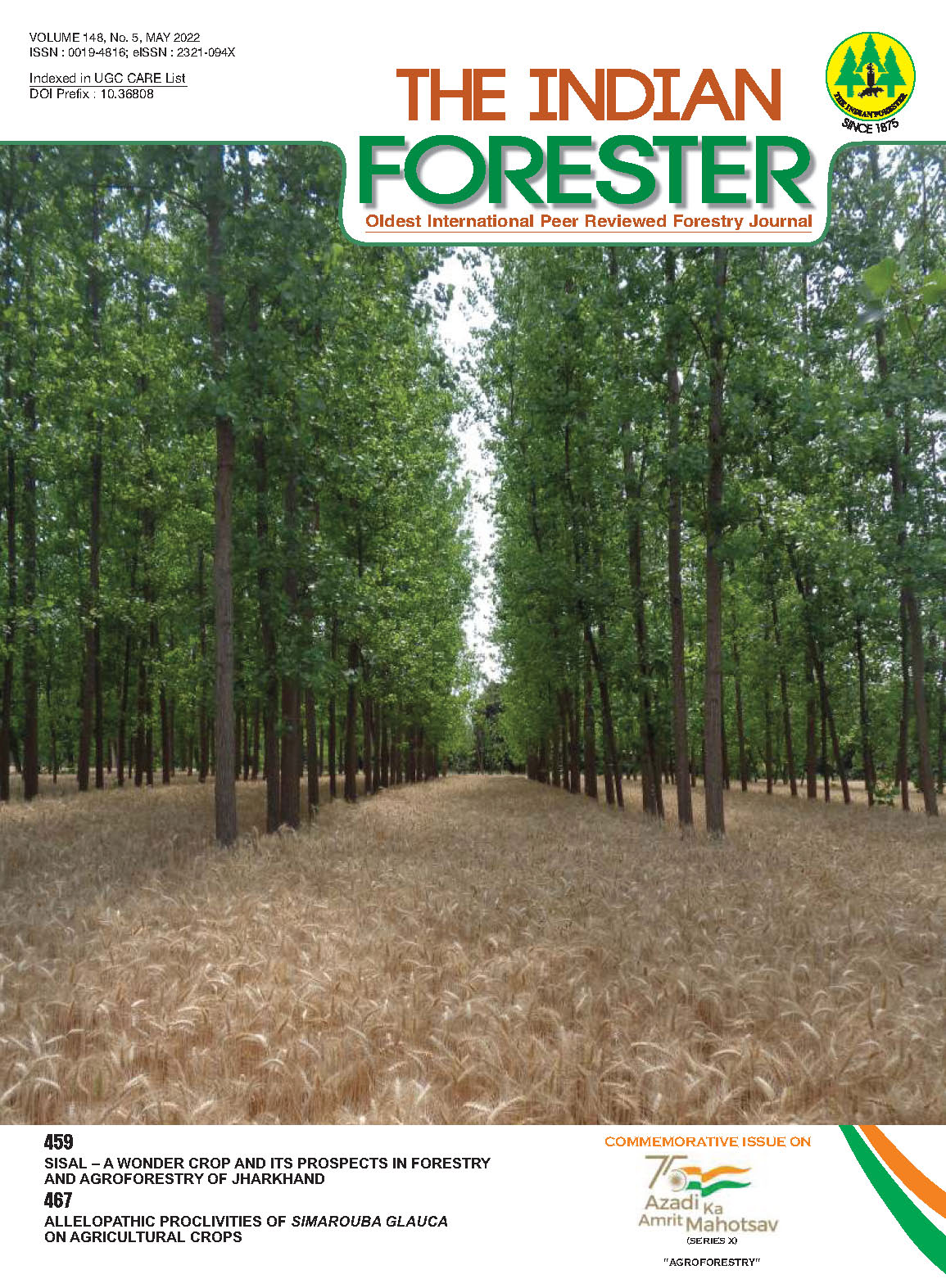Tree Fodder Production to Bridging the Gap between the Need and Availability of Animal Fodder
DOI:
https://doi.org/10.36808/if/2022/v148i5/154734Keywords:
Livestock rearing, Fodder trees, Fodder Shrubs, Agroforestry systems, Fodder status, Trees for erosion control, Watershed, Nutritive value of leaf fodder.Abstract
Livestock provides sustenance to rural community by providing food security through supply of milk, meat and self-employment however additionally plays a vital role for poverty alleviation of farmers. The area under fodder trees and shrubs is meager and is less than one per cent of the total cultivated land. Presence of inferior and unproductive grass and tree species, lack of fertilization, absence of legume component, improper cutting and indiscriminate grazing are the factors accountable for poor productivity of the grasslands and tree lands. Thus, the present paper provides an insight into the fodder trees potentiality, constraints in its production, challenges and strategies to improve the productivity of grassland and tree lands. Promoting fodder tree planting in degraded and grazing lands facilitates to meet livestock needs for fodder and trees helps to alleviate degradation. Keeping in view the constraints in fodder production to beat the gap between demand and supply, the emphasis need to be given on various steps for augmenting the fodder production. Fodder production is a component of the farming system and efforts have to be made for increasing the forage production in a farming system approach.
References
th Livestock Census (2012). Department of animal husbandry and dairying. Govt. of India.
Arif M., Singh M., Onte Santosh, Dey D. and Kumar R. (2020). Comparative evaluation of fodder qualities in different parts of locally available moringa (Moringa oleifera) strains. Indian Journal of Animal Sciences, 90(1): 80-84.
Paatanayak A., Bisht J.K., Yadav R.P. and Pandey B. (2019). Fodder tree based agroforestry systems in hills of Uttarakhand. In book: Agroforestry for Climate Resilience and Rural Livelihood; Publisher: Scientific Publishers
Chen C.P., Halim R.A. and Chin Y.Y. (1992). Fodder trees and fodder shrubs in range and farming systems of the Asian and pacific region, legume trees and other fodder trees as protein sources for livestock. Proceedings of the FAO Expert Consultation held at the Malaysian Agricultural Research and Development Institute (MARDI) in Kuala Lumpur, Malaysia.
Draft report of the working group on animal husbandry and dairying for five-year plan (2002-2007, Govt. of India, Planning Commission, August - 2001).
Jamala G.Y., Tarimbuka I.L., Moris D. and Mahai S. (2013). The scope and potentials of fodder trees and shrubs in agroforestry. Journal of agriculture and Veterinary Science, 5(4), pp.11-17.
Kamalak A., Canbolat Y. Gurbuz O. Ozay, C.O. Ozkan and M. Sakarya (2004). chemical composition and in vitro gas production characteristics of several tannin containing tree leaves. Livestock Research Rural Development.
Kamini S.N. Ram and S.S. Manjanagouda (2020). Hardwickia binata: A valuable fodder tree species of semi-arid region. EBulletin. ICAR-Indian Grassland and Fodder Research Institute, Jhansi, UP, India. pp. 1₋32.
Lemes A.P., Garcia A.R., Pezzopane J.R.M., Brandao F.Z., Watanabe Y.F., Cooke R.F., Sponchiado M., Paro De Paz C.C., Camplesi A.C., Binelli M. and Gimenes L.U. (2021). Silvopastoral system is an alternative to improve animal welfare and productive performance in meat production systems. Scientific Reports, 11, 14092.
Moyo B., Patrick J., Masika P.J., Hugo A. and Muchenje V. (2011). Nutritional characterization of moringa (Moringa oleifera Lam.) leaves. African Journal of Biotechnology, 10(60): 12925-33.
Nouman W., Basra S.M.A., Siddiqui M.T., Yasmeen A., Guli T. and Alacyde M.A.C. (2014). Potential of Moringa oleiferaL. as livestock fodder crop: A review. Turkish Journal of Agriculture and Forestry, 38: 1-14.
Olugbemi T.S., Mutayoba S.K. and Lekule F.P. (2010). Effect of moringa (Moringa oleifera) inclusion in cassava based diets fed to broiler chickens. International Journal of poulty Sciences 9: 363-67.
Raghavan G.V. (1990). Availability and use of shrubs and tree fodder in India. In: Devendra C. (ed.), Shrubs and tree fodders for farm animals. Proceedings of a workshop in Denpasar, Indonesia, 24-29 July 1989. IDRC-276e, Ottawa, Ontario, PP.196-210.
Samia M.Y., Elbadri O.E., Eltahir A.S., Mohammed E.E. and Ahmed K.S. (2018). Proximate Composition of Moringa oleifera Lam. from different Regions in Sudan. CPQ Microbiology, 1(4): 1-13.
Sales-Baptista E. and Ferraz-de-Oliveira M.I. (2021). Grazing in silvopastoral systems: multiple solutions for diversified benefits. Agroforestry Systems, 95, 1-6.
Singh R.V. (1982). Fodder trees in India. Oxford and IBH Publishing Co., New Delhi, India. 663 p.
Smith O.B. (1992). Fodder trees and shrubs in range and farming systems in tropical humid Africa. Proceedings of the FAO Expert Consultation held at the Malaysian Agricultural Research and Development Institute (MARDI) in Kuala Lumpur, Malaysia.
Taku T., Santra A., Barik S., Mandal D.K. and Das S.K. (2019). Assessment of fodder quality and methane production potential of north-eastern Himalayan forest tree leaves. The Indian journal of animal sciences, 89(1): 90-96.
Verma K.S. and Nigam R. (2014). Nutritional assessment of different parts of Moringa oleifera Lamm collected from Central India. Journal of Natural Product and Plant Resources, 4(1): 81-6.
Vision (2050). Indian Grassland and Fodder Research Institute (Indian Council of Agricultural Research), June 2013.
Downloads
Downloads
Published
How to Cite
Issue
Section
License
Unless otherwise stated, copyright or similar rights in all materials presented on the site, including graphical images, are owned by Indian Forester.





